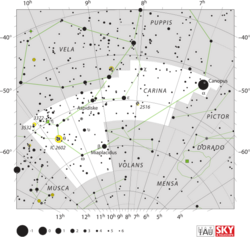Astronomy:Chi Carinae
| Observation data Equinox J2000.0]] (ICRS) | |
|---|---|
| Constellation | Carina |
| Right ascension | 07h 56m 46.690s[1] |
| Declination | −52° 58′ 55.95″[1] |
| Apparent magnitude (V) | +3.6[1] |
| Characteristics | |
| Spectral type | B3IVp[1] |
| U−B color index | −0.670[2] |
| B−V color index | −0.182[2] |
| Variable type | None[3] |
| Astrometry | |
| Radial velocity (Rv) | +19.4[4] km/s |
| Proper motion (μ) | RA: −28.68[5] mas/yr Dec.: +19.71[5] mas/yr |
| Parallax (π) | 7.17 ± 0.47[5] mas |
| Distance | 450 ± 30 ly (139 ± 9 pc) |
| Absolute magnitude (MV) | −2.25[6] |
| Details | |
| Mass | 7.0 ± 0.1[7] M☉ |
| Radius | 5.5[8] R☉ |
| Luminosity | 2,266[6] L☉ |
| Surface gravity (log g) | 3.5[9] cgs |
| Temperature | 17,200[9] K |
| Rotational velocity (v sin i) | 110[10] km/s |
| Age | 39.8 ± 4.7[7] Myr |
| Other designations | |
χ Car, CPD–52° 1343, FK5 303, HD 65575, HR 3117, HIP 38827, SAO 235635[11] | |
| Database references | |
| SIMBAD | data |
Chi Carinae, Latinised from χ Carinae (US: /kaɪ kəˈraɪniː/),[12] is a star in the southern constellation of Carina. It is a third-magnitude[2] star and is one of the brighter members of the constellation. The distance to the star can be determined directly through parallax measurements, yielding an estimate of roughly 450 light-years (140 parsecs) with a 6.7% margin of error.[5] This star is a suspected astrometric binary,[13] although nothing is known about the companion.[14]
This is a massive star, with about seven times the mass of the Sun.[7] It is about 40[7] million years old and rotating rapidly; the projected rotational velocity has been measured as high as 110 km s−1.[10] The spectrum of this star matches a stellar classification of B3 IV,[15] with the luminosity class of IV indicating this is likely a subgiant star that has nearly exhausted the supply of hydrogen at its core and is in the process of evolving into a giant star.
In 1969, Chi Carinae was classified as chemically peculiar Ap star[16] because its absorption lines of silicon appeared unusually strong relative to the lines for helium. However, subsequent examination in the ultraviolet band showed the silicon bands were as expected and it was determined the spectra is normal for a star of its type. There is no indication of variability in the star's spectrum.[7] Observation during the Hipparcos mission showed no photometric variability down to a limit of ±0.003 magnitude. For this reason, the star has been ruled out as a Beta Cephei-type variable star.[3]
References
- ↑ 1.0 1.1 1.2 1.3 Frosty Drew Observatory & Sky Theatre — Chi Carinae
- ↑ 2.0 2.1 2.2 Cousins, A. W. J. (1972), "UBV Photometry of Some Very Bright Stars", Monthly Notes of the Astronomical Society of Southern Africa 31: 69, Bibcode: 1972MNSSA..31...69C
- ↑ 3.0 3.1 Stankov, Anamarija; Handler, Gerald (June 2005), "Catalog of Galactic β Cephei Stars", The Astrophysical Journal Supplement Series 158 (2): 193–216, doi:10.1086/429408, Bibcode: 2005ApJS..158..193S
- ↑ Evans, D. S. (June 20–24, 1966). "The Revision of the General Catalogue of Radial Velocities". in Batten, Alan Henry; Heard, John Frederick. Determination of Radial Velocities and their Applications, Proceedings from IAU Symposium no. 30. 30. University of Toronto: International Astronomical Union. 57. Bibcode: 1967IAUS...30...57E.
- ↑ 5.0 5.1 5.2 5.3 van Leeuwen, F. (November 2007), "Validation of the new Hipparcos reduction", Astronomy and Astrophysics 474 (2): 653–664, doi:10.1051/0004-6361:20078357, Bibcode: 2007A&A...474..653V
- ↑ 6.0 6.1 Anderson, E.; Francis, Ch. (2012), "XHIP: An extended hipparcos compilation", Astronomy Letters 38 (5): 331, doi:10.1134/S1063773712050015, Bibcode: 2012AstL...38..331A.
- ↑ 7.0 7.1 7.2 7.3 7.4 Tetzlaff, N.; Neuhäuser, R.; Hohle, M. M. (January 2011), "A catalogue of young runaway Hipparcos stars within 3 kpc from the Sun", Monthly Notices of the Royal Astronomical Society 410 (1): 190–200, doi:10.1111/j.1365-2966.2010.17434.x, Bibcode: 2011MNRAS.410..190T
- ↑ Underhill, A. B. et al. (November 1979), "Effective temperatures, angular diameters, distances and linear radii for 160 O and B stars", Monthly Notices of the Royal Astronomical Society 189 (3): 601–605, doi:10.1093/mnras/189.3.601, Bibcode: 1979MNRAS.189..601U
- ↑ 9.0 9.1 Leone, F.; Catanzaro, G. (March 1998), "A spectroscopic study of some suspected chemically peculiar stars", Astronomy and Astrophysics 331: 627–632, Bibcode: 1998A&A...331..627L
- ↑ 10.0 10.1 Bernacca, P. L.; Perinotto, M. (1970). "A catalogue of stellar rotational velocities". Contributi Osservatorio Astronomico di Padova in Asiago 239 (1): 1. Bibcode: 1970CoAsi.239....1B.
- ↑ "chi Car". SIMBAD. Centre de données astronomiques de Strasbourg. http://simbad.u-strasbg.fr/simbad/sim-basic?Ident=chi+Car.
- ↑ OED https://www.oed.com/view/Entry/27984?redirectedFrom=Carina#eid https://www.oed.com/view/Entry/31494?rskey=iJyg4s&result=1&isAdvanced=false#eid
- ↑ Frankowski, A.; Jancart, S.; Jorissen, A. (March 2007), "Proper-motion binaries in the Hipparcos catalogue. Comparison with radial velocity data", Astronomy and Astrophysics 464 (1): 377–392, doi:10.1051/0004-6361:20065526, Bibcode: 2007A&A...464..377F
- ↑ Eggleton, P. P.; Tokovinin, A. A. (September 2008). "A catalogue of multiplicity among bright stellar systems". Monthly Notices of the Royal Astronomical Society 389 (2): 869–879. doi:10.1111/j.1365-2966.2008.13596.x. Bibcode: 2008MNRAS.389..869E.
- ↑ Houk, Nancy (1978), Michigan catalogue of two-dimensional spectral types for the HD stars, 1, Ann Arbor: Dept. of Astronomy, University of Michigan, Bibcode: 1975mcts.book.....H
- ↑ Hiltner, W. A.; Garrison, R. F.; Schild, R. E. (July 1969), "MK Spectral Types for Bright Southern OB Stars", Astrophysical Journal 157: 313, doi:10.1086/150069, Bibcode: 1969ApJ...157..313H
 |


